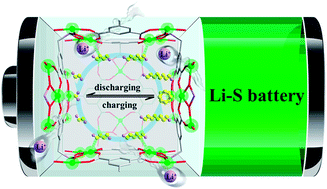Manganese cluster-based MOF as efficient polysulfide-trapping platform for high-performance lithium–sulfur batteries†
Abstract
Lithium-sulfur (Li–S) batteries have attracted wide attention due to their outstanding properties of high theoretical specific capacity and energy density. However, drawbacks such as the polysulfide shuttle effect have hampered their further practical application. Metal–organic frameworks (MOFs) have stimulated increasing interest in energy storage and conversion. In MOFs, the metal ions can be activated to provide open metal Lewis acid sites to restrain polysulfides. Aiming at sensible solutions, a novel manganese cluster-based MOF equipped with cubic cages, which are walled with abundant open-metal sites (OMSs) obtained from 9-manganese nodes, is used as the cathode host of Li–S batteries. The activated MOF not only provided physical capture and chemical adsorption against polysulfide shuttle but also allowed efficient impregnation of sulfur to facilitate mass transport. Benefiting from these synergetic effects, the composite cathode delivers enhanced electrochemical performance. The battery showed a remaining capacity of about 990 mA h g−1 after 200 cycles at 0.2C and an approximately repeatable rate performance. Significant contribution of the exposed functional metal sites was demonstrated by XPS and SEM of the electrode materials.



 Please wait while we load your content...
Please wait while we load your content...